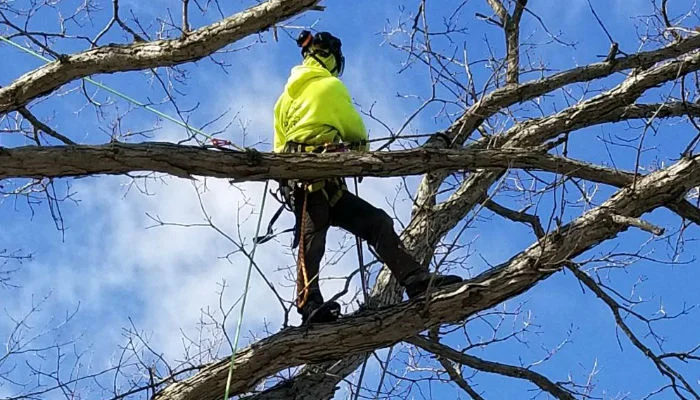Tree Climbing For Work And Recreation
J's performs jobs on the ground AND in the air. Our crews are not only Climbers but certified Boom Operators so we can access those hard to reach trims from the ground. But a boom can only go so far. For the trees that need a little extra something, we employ experienced tree climbers. No tree is too tall for our crews!
Technical (rope and harness) tree climbing requires skill and practice to master. The skills required can be taught so that just about anybody —no matter their age — can do it! A skilled tree climber performs one of the safest activities on earth. In fact, according to Tree Climbers International, they state:
"to date we know of no incidents anywhere in the world in which a recreational tree climber using the TCI system and safety protocols has fallen or gotten hurt."
In addition to the skill necessary, proper equipment is imperative. One such item is a harness.
A harness, belt or saddle, depending on where the climber hangs their hard hat or saw, is an intimate part of every working day, often spending a lot more time in contact with the user’s body than anything else in their life.
There are four basic types of industrial harnesses and many tree industry specific harnesses will have elements of each one:
- Fall restraint: This system is meant to prevent the user from getting into a position where they can fall. It’s pretty limited in tree work and would most commonly be seen in the use of a body belt with the appropriate lanyard in an aerial lift or device. The right length lanyard used with a fall-restraint harness is the key component, as it is what prevents the user from getting to a spot where a fall could occur.
- Fall arrest: This system is supposed to stop a fall, as well as lessen the forces and possible injuries. In tree care, these types of systems are most often called full-body harnesses and are often used in aerial lifts, though some can also be used for climbing.
- Work positioning: This gives the climber the ability to position themselves safely and correctly to carry out the needed work, preventing a fall while keeping the hands free. Side attachment points or D-rings are a good example of work positioning.
- Suspension: Its purpose is to sort of cradle the climber in an upright, slightly seated position while tied in above. When setup properly, it can also allow stable work positioning with both hands free.
Source: Tree Services, October 2012

